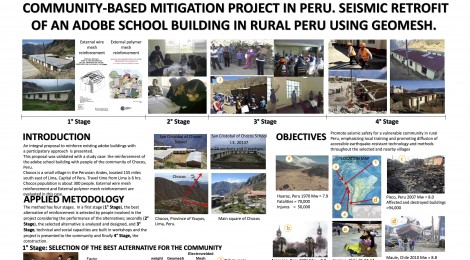
Community-Based Mitigation Project in Peru: Seismic Retrofit of an Adobe School Building in Rural Peru Using Geomesh
This post is another in our series presenting member research, focused primarily on the many insightful posters presented at this year’s conference.
Jose Quispe Acosta
The goal of this project was to assess the ability of community members to reinforce existing adobe school buildings in Chocos, Peru, a small mountain town located 155 miles to the east south of Lima city and 2700 meters above sea level, in the Peruvian Andes. Local community participation included selecting the reinforcement mechanism, analyzing and designing the reinforcement, and learning techniques in a workshop. The Chocos´s San Cristobal School, an existing adobe building, was retrofitted applying geomesh, a strong polymer netting, to school walls by the community (children, homeowners, construction workers). This project was successfully designed, implemented and validated through the participation of the local community, Geohazards International, NGO Estrategia, Stanford University (Stanford Civil & Environmental Engineering, Engineers for a Sustainable World and The John A. Blume Earthquake Center), Pontifical Catholic University of Peru (teachers and students of the departments of Social Sciences, Architecture and Engineering) and the council of Chocos. Three months after this experience, one adobe house was reinforced by the people of Chocos, using the knowledge provided by this project. Results show a clear potential in improving the earthquake safety of their buildings.
 The study presented in the poster was motivated by a desire to continue with the applied research proposals carried out mainly at the Pontificia Universidad Catolica del Peru, Peru, since 1978, to reduce the seismic risk of vulnerable communities in Rural Peru and to improve the seismic resistant of adobe constructions. Another important motivational factor was the GHI´s “School Earthquake Safety Project” in Nepal. This has allowed to work with multidisciplinary groups and to know other cultures with different responses.
The study presented in the poster was motivated by a desire to continue with the applied research proposals carried out mainly at the Pontificia Universidad Catolica del Peru, Peru, since 1978, to reduce the seismic risk of vulnerable communities in Rural Peru and to improve the seismic resistant of adobe constructions. Another important motivational factor was the GHI´s “School Earthquake Safety Project” in Nepal. This has allowed to work with multidisciplinary groups and to know other cultures with different responses.
The project resulted in ‘Happiness, gratitude and acceptance of the community of Chocos and Adobe Building Retrofits using Geomesh.’ It also promoted seismic risk awareness and knowledge of earthquake-resistant construction throughout the village of Chocos and nearby villages.
The next step will be to need people that help to spread and share the information between themselves and with nearby communities to achieve the social sustainability of our communities. Also, to continue studying and exploring these issues, such as adequate water supply, seismic safety and other topics in civil engineering, in any part of the world with great expectations.
In the future, this project might lead to showing the community particular past experiences (outcomes and lessons learned) of other similar projects and involving government authorities. It could also lead to pressure on the government to implement policies and programs recognizing people´s needs and interests.
About Quispe Acosta’s experience with the poster presentation: ‘Exchange of information about social sustainability between different specialists in many areas allowed me to share my research and have key ideas about social sustainability of other interesting projects to incorporate them in the next programs, plans, activities and researches. I am extremely grateful to all the researchers of the Poster Presentations for their researches and results. This and the conference encourage continuing developing the social sustainability in the world.’
Jose Quispe Acosta is a graduate student at the Pontificia Universidad Católica del Perú
This post was developed from Quispe Acosta’s poster abstract and answers to interview questions by email. Please post any questions in the comments.


